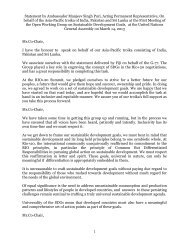STATE OF THE WORLD'S CITIES 2012/2013 Prosperity
STATE OF THE WORLD'S CITIES 2012/2013 Prosperity
STATE OF THE WORLD'S CITIES 2012/2013 Prosperity
You also want an ePaper? Increase the reach of your titles
YUMPU automatically turns print PDFs into web optimized ePapers that Google loves.
State of the World’s Cities <strong>2012</strong>/<strong>2013</strong><br />
about user rights for<br />
As cities work enhanced human value.<br />
POLICy on the five<br />
The ‘Right to<br />
dimensions of prosperity,<br />
the Commons’ is an<br />
there also occurs a<br />
progressive expansion in<br />
ancient concept in legal<br />
the size of the commons. jurisprudence originating<br />
More amenities are brought in feudal England, where<br />
into collective use and more it referred to the extension<br />
access is provided, enabling of user rights for all on<br />
larger numbers of urban<br />
a manor’s grazing land.<br />
residents to use and enjoy<br />
shared spaces, services and<br />
Lately, the notion has<br />
facilities.<br />
resurfaced in urban settings<br />
(including public goods,<br />
societal institutional<br />
arrangements, public<br />
culture, and heritage sites),<br />
The capacity for<br />
FACT a city to maintain where it is perceived as an<br />
extensive and quality<br />
effective way of countering<br />
shared spaces and facilities not just rampant enclosures<br />
provides a good indication and appropriations, but<br />
of its degree of prosperity.<br />
also the rise of duality<br />
under the form of inequity<br />
and segregation.<br />
In this respect, cities such as Helsinki, Toronto and<br />
Barcelona, which achieve high rankings on the UN-<br />
Habitat City <strong>Prosperity</strong> Index (CPI), feature more<br />
extensive public realms than Monrovia, Nairobi or Dakar,<br />
or similar cities with low CPI readings.<br />
Legal and regulatory instruments exert a major<br />
bearing on the origination and preservation of the<br />
commons, and also in ensuring indiscriminate access.<br />
Statutes, ordinances and regulations are the bases for the<br />
guidelines and standards regulating spatial layouts and<br />
construction designs. The same applies to institutional<br />
relationships, functional<br />
allocations and authority<br />
designation, besides<br />
In this era of<br />
resource distribution. The<br />
FACT enclosures,<br />
privatization and even<br />
legal framework in turn<br />
invasion of the traditional enables civic organisations<br />
urban commons (including and community activities.<br />
beaches, river banks,<br />
Equally significant is the<br />
forests, school yards and<br />
overall manner in which<br />
even pavements), the size<br />
legal-regulatory and<br />
and quality of a city’s overall<br />
public space acts as a<br />
institutional frameworks<br />
good indicator of shared delineate the public and<br />
prosperity.<br />
private spheres and guide<br />
the interaction between<br />
118<br />
and within them in the everyday workings of the city.<br />
One component of the commons that lately has<br />
attracted a lot of attention is the management of public<br />
spaces. 56 In Panama City, one of the local experts surveyed<br />
by UN-Habitat put it as follows: “The more degraded<br />
public space, the more degraded the citizen, because public<br />
space is not only about quality of life but also the expression<br />
of citizenship”. 57 Another local expert, in Santo Domingo,<br />
underscored the same point perhaps more incisively:<br />
“Citizens need to gain positive empowerment, to defend<br />
space enclaves where public life is still alive and where laws<br />
and norms for doing so are available.” 58<br />
REvISITING URBAN CODES FOR SHARED<br />
PROSPERITy<br />
Rules and regulations constitute a key instrument in urban<br />
management and development. That is why appropriate<br />
institutions are required to ensure implementation<br />
and enforcement as well as awareness building and<br />
mobilization. Rules and regulations have significant roles<br />
to play, as they generally steer and circumscribe planning<br />
and construction. One author has even gone so far as to<br />
ascribe the ‘shaping and misshaping of American cities’ to<br />
poor planning regulations. 59 Indeed, zoning regulations,<br />
building codes, utility standards, deed restrictions and<br />
the many other instruments that shape the urban built<br />
environment, will determine not only the pattern, use<br />
and form of spaces and structures, but will also strongly<br />
influence the quality of life in cities.<br />
The review of regulatory frameworks is of particular<br />
importance for those cities in the developing world that<br />
have long operated with<br />
externally derived standards<br />
and codes, who, must<br />
also tend to effective<br />
implementation and<br />
enforcement capacities.<br />
Revisiting the codes<br />
developed for formerly<br />
colonial or apartheid cities<br />
like Nairobi, Dar es Salaam<br />
or Johannesburg in a bid<br />
to achieve an inclusive<br />
urban form is a challenging<br />
endeavour. This calls not<br />
only major for institutional<br />
restructuring, but also a<br />
revision of zoning and<br />
POLICy Laws,<br />
rules and<br />
institutions must<br />
be kept alert, not<br />
inert, to current and<br />
evolving needs and<br />
risks if a city’s whole<br />
human potential is<br />
to be harnessed,<br />
not repressed –<br />
empowering the whole<br />
population with “basic<br />
capabilities” or “generic<br />
conditions of agency”<br />
at the service of<br />
today’s and tomorrow’s<br />
prosperity.




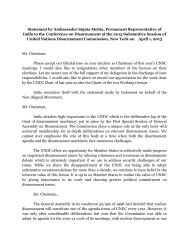
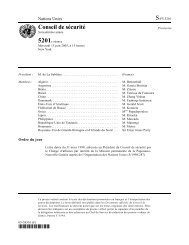
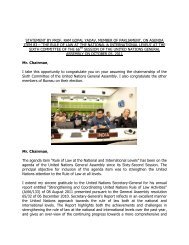
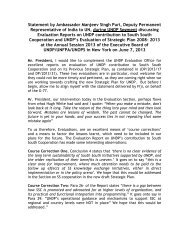
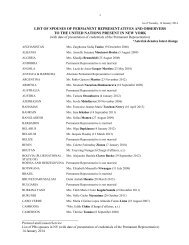
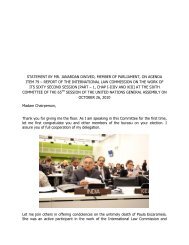
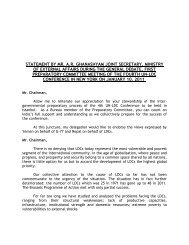
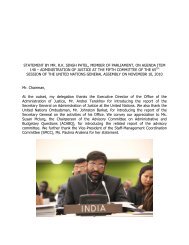

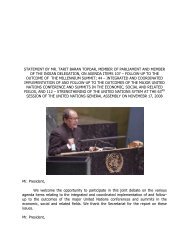
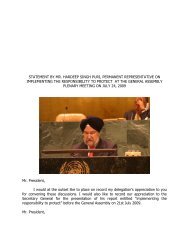
![1 statement by dr.[mrs] kakoli ghosh dastidar - Member States Portal](https://img.yumpu.com/27526598/1/190x245/1-statement-by-drmrs-kakoli-ghosh-dastidar-member-states-portal.jpg?quality=85)
